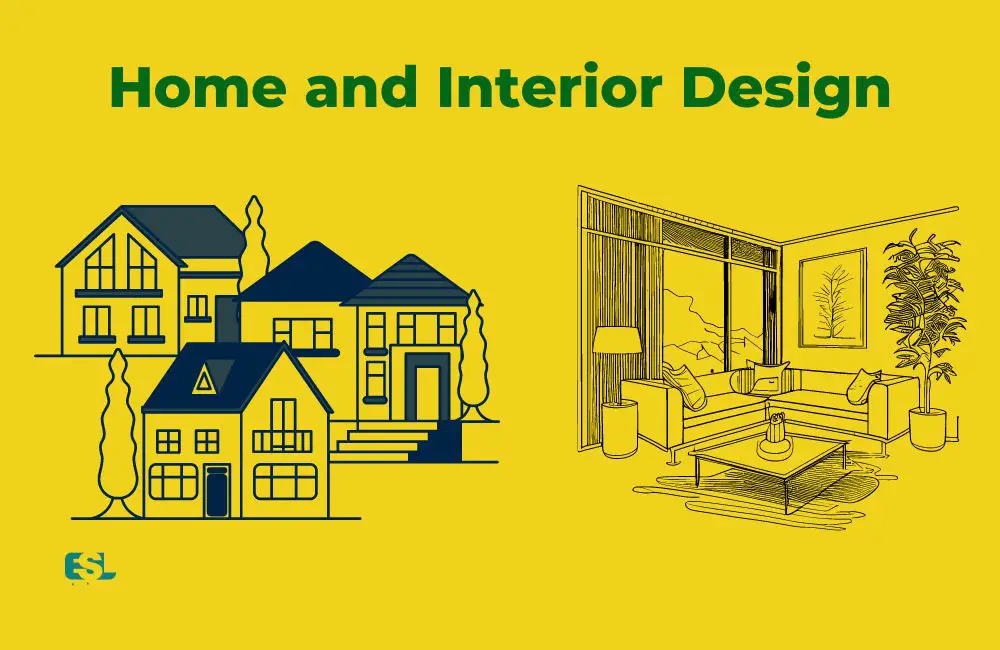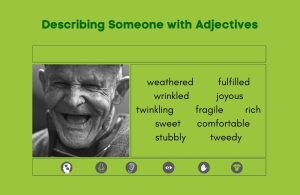Whether you’re a professional interior designer, a homeowner looking to redecorate, or someone with a keen interest in home aesthetics, understanding home and interior design can greatly enhance your ability to create beautiful, functional spaces.
This article provides a comprehensive list of essential home and interior design vocabulary, divided into various categories for ease of understanding.
Table of Contents
- 1. Furniture Types
- 2. Design Styles
- 3. Room Types
- 4. Materials
- 5. Colors
- Sample Conversation: Using Vocabulary Related to Home and Interior Design
- Conclusion
- FAQ: Vocabulary Related to Home and Interior Design
1. Furniture Types
Furniture is a major element of any interior design plan. These terms will help you identify and discuss various types of furniture.
| Word/Phrase | Meaning/Usage | Example Sentences |
|---|---|---|
| Armchair | A comfortable chair with side supports for a person’s arms | “The living room has a cozy armchair by the fireplace.” |
| Ottoman | An upholstered seat or bench without a back, typically used as a stool or footrest | “She placed the ottoman in front of the sofa.” |
| Sectional | A type of couch composed of multiple sections that can be arranged in different configurations | “The sectional sofa fits perfectly in the corner of the room.” |
| Loveseat | A small sofa designed for two people | “They cuddled on the loveseat while watching a movie.” |
| Sideboard | A flat-topped piece of furniture with cupboards and drawers, used for storing dishes, glasses, and table linens | “The sideboard in the dining room holds all our special occasion dishes.” |
| Credenza | A kind of sideboard used in the home or office | “The office has a beautiful, antique credenza.” |
| Wardrobe | A large, tall cabinet in which clothes may be hung or stored | “The bedroom has a spacious built-in wardrobe.” |
| Armoire | A wardrobe or movable cabinet, typically one that is ornate or antique | “The vintage armoire in the bedroom is a family heirloom.” |
| Vanity | A dressing table equipped with mirrors and drawers | “She applies her makeup at her bedroom vanity.” |
| Hutch | A piece of furniture with a set of shelves or cabinets placed on top of a lower unit with a counter and drawers | “The kitchen hutch is filled with vintage china.” |
| Chaise longue | A chair with a long seat to support the outstretched legs of the user | “The patio has a couple of chaise longues for sunbathing.” |
To elevate your vocabulary in just 30 days, I recommend to my students an informative, fun, and accessible guide to utilizing powerful language. Millions of individuals have enhanced their academics, job skills, and confidence by dedicating just fifteen minutes daily to the exercises and tests of 30 Days to a More Powerful Vocabulary (Amazon Link), a top-selling. It offers step-by-step methods to bolster language prowess, discover compelling words, and daily vocabulary enhancement with pronunciation guidance.
2. Design Styles
There are countless design styles, each with its unique characteristics. Here are some commonly referenced styles in interior design.
| Word/Phrase | Meaning/Usage | Example Sentences |
|---|---|---|
| Modern | Characterized by simplicity, clean lines, and a monochromatic color palette | “The house has a sleek, modern design.” |
| Contemporary | Characterized by current trends, featuring a mix of all styles, flexible and ever-changing | “Her apartment is decorated in a contemporary style.” |
| Industrial | Design style that takes inspiration from old factories and industrial spaces, characterized by weathered wood, building systems, exposed brick, industrial lighting fixtures, and concrete | “The loft has an industrial design, with exposed brick and metal accents.” |
| Mid-century modern | A design movement from roughly 1933 to 1965 characterized by a simple and minimalist approach, natural shapes, and an emphasis on functionality | “The living room has a mid-century modern aesthetic.” |
| Minimalist | A design style characterized by extreme spareness and simplicity | “He prefers a minimalist style with a neutral color palette.” |
| Traditional | A design style that incorporates classic designs, comfortable furniture, and casual décor | “The house has a traditional design, with antique furniture and cozy accents.” |
| Bohemian | A design style characterized by vibrant colors, rich patterns, a variety of textures and materials, and a relaxed, carefree vibe | “Her apartment is bohemian, with colorful rugs and throw pillows.” |
| Rustic | Design style that emphasizes natural beauty, with elements such as raw wood, stone, and leather, often with a touch of the outdoors | “The cabin has a rustic design, with exposed wood beams and a stone fireplace.” |
| Shabby chic | A style characterized by items that are chosen for their appearance of age and signs of wear and tear, or new items that are distressed to achieve the look of an antique | “The bedroom is shabby chic, with distressed furniture and a pastel color scheme.” |
| Art deco | A design style of the 1920s and 1930s characterized by bold geometric shapes and strong colors | “The hotel lobby boasts an elegant art deco design.” |
| Scandinavian | Design style characterized by simplicity, minimalism, and functionality, often incorporating white walls, wooden floors, and modern furniture | “The home has a Scandinavian design, with a simple color palette and functional furnishings.” |
3. Room Types
Knowing how to refer to different types of rooms properly can be helpful when discussing design plans. Here are some common room types found in homes.
| Word/Phrase | Meaning/Usage | Example Sentences |
|---|---|---|
| Living room | A room in a house for general and informal everyday use | “The living room has a comfortable, welcoming vibe.” |
| Dining room | A room where meals are eaten | “The dining room can accommodate a large table and eight chairs.” |
| Kitchen | A room where food is prepared and cooked | “The kitchen features modern appliances and ample counter space.” |
| Bedroom | A room for sleeping in | “The house has three bedrooms.” |
| Bathroom | A room containing a bathtub or shower and usually a toilet and sink | “The master suite includes a large bathroom with a jacuzzi tub.” |
| Office | A room where work or business is conducted | “She converted the spare room into a home office.” |
| Nursery | A room in a house designated for the care of babies and young children | “The nursery is decorated with a charming jungle theme.” |
| Recreation room (Rec room) | A room for recreational activities such as games, hobbies, or entertainment | “The basement was transformed into a spacious rec room with a pool table.” |
| Mudroom | A room in a house designed to act as a barrier between outdoors and indoors, particularly for storing shoes, outerwear, and wet clothes | “The mudroom is handy for storing boots and coats in the winter.” |
| Laundry room | A room where clothes are washed and dried | “The laundry room features a new washer and dryer.” |
| Attic | The space or room at the top of a building, under the roof, often used for storage or converted into living quarters | “The attic has been converted into a cozy guest room.” |
4. Materials
Different materials bring different looks and feel to a space. Here are some common materials used in home and interior design.
| Word/Phrase | Meaning/Usage | Example Sentences |
|---|---|---|
| Hardwood | Durable, often glossy material used for flooring | “The house features beautiful hardwood floors throughout.” |
| Tile | Thin objects, usually square or rectangular in shape, used for covering roofs, floors, walls, or other objects | “The bathroom is finished with ceramic tile.” |
| Marble | A hard crystalline metamorphic form of limestone, used for countertops and floors | “The kitchen boasts a large marble island.” |
| Quartz | A hard, crystalline mineral often used for kitchen and bathroom countertops | “The bathroom counters are made of quartz.” |
| Concrete | A hard, durable material made by mixing cement with sand, gravel, and water, often used for floors and countertops | “The living room features polished concrete flooring.” |
| Stainless steel | A form of steel containing chromium, resistant to tarnishing and rust, often used for kitchen appliances and fixtures | “The kitchen has stainless steel appliances.” |
| Velvet | A type of woven tufted fabric in which the cut threads are distributed in an even manner in a short dense pile, often used for upholstery | “The velvet armchair adds a touch of luxury to the living room.” |
| Leather | A material made from the skin of an animal, used for furniture upholstery | “The study has a classic leather armchair.” |
| Wallpaper | Material used to cover and decorate the interior walls of homes, offices, and other buildings | “She chose a floral wallpaper to brighten up the room.” |
| Carpet | A textile floor covering, typically consisting of an upper layer of pile attached to a backing | “The bedroom has a plush, neutral carpet.” |
| Laminate | A synthetic material made from multiple layers fused together, often used for flooring or countertops | “The office has durable laminate flooring.” |
5. Colors
Colors play a significant role in interior design, affecting the mood and overall feel of a space. Here are some common color terms used in the design.
| Word/Phrase | Meaning/Usage | Example Sentences |
|---|---|---|
| Neutral | Colors not usually found on the color wheel, such as black, white, grey, and sometimes brown and beige | “The room has a neutral color scheme, making it easy to add pops of color with accessories.” |
| Monochromatic | A color scheme based on variations of a single hue | “The monochromatic blue palette of the room is calming and cohesive.” |
| Complementary | Colors that are directly opposite each other on the color wheel and when combined, they produce a grayscale color | “The room uses complementary colors, orange and blue, for a vibrant contrast.” |
| Analogous | Colors that are next to each other on the color wheel | “The analogous color scheme of red, orange, and yellow gives the room a warm, autumnal feel.” |
| Cool colors | Colors such as blue, green, and light purple that have a calming effect | “The bedroom uses cool colors to promote relaxation.” |
| Warm colors | Colors such as red, yellow, and orange that evoke warmth because they remind us of things like the sun or fire | “The living room has a cozy vibe with its warm color scheme.” |
| Pastel | Soft and delicate hues that have high value or lightness and low to medium saturation | “The nursery is decorated in soft pastels.” |
| Vibrant | Bright and striking colors | “The vibrant green walls give the room a lively feel.” |
| Shade | A color produced by adding black to any pure hue, reducing its brightness | “She chose a dark shade of blue for the dining room walls.” |
| Tint | A color produced by adding white to any pure hue, increasing its lightness | “The walls are painted in a soft tint of green.” |
If you are searching for an effective English language vocabulary builder, try Word Power Made Easy: The Complete Handbook for Building a Superior Vocabulary (Amazon Link). This time-tested classic has helped millions achieve mastery of English and improve their communication skills in business, the classroom, and in life.
Sample Conversation: Using Vocabulary Related to Home and Interior Design
Situation: At a home decor exhibition, interior designer Helena chats with homeowner Jake about modern trends and design concepts.
Helena: Jake, I’ve seen a shift towards minimalism in recent years. It emphasizes clean lines, decluttered spaces, and a ‘less is more’ approach.
Jake: I’ve noticed that, Helena. My living room feels a bit outdated, and I’m thinking of a contemporary redesign. Maybe some neutral tones with a few accent pieces?
Helena: That sounds refreshing! Neutral tones like beige, gray, or off-white can make a space feel larger and more cohesive. Using accent colors or items can then add personality and focal points.
Jake: I’ve got these large windows, and I’m trying to decide on the right window treatments. I want something that offers privacy but still lets in light.
Helena: Consider sheer curtains or roman shades. They’re stylish and provide a balance between privacy and natural light. And don’t forget about ambient lighting for evenings.
Jake: Great suggestion! For the bedroom, I’m looking at wallpapers with subtle patterns. It should be calming and tie the room together.
Helena: Absolutely. A gentle geometric or floral pattern can add depth without being overwhelming. Pair it with matching bed linens and throw pillows, and you’ll have a harmonious design.
Conclusion
Understanding the terminology of home and interior design is the first step toward bringing your unique vision to life. Whether designing a new space or simply communicating with professionals in the field, this comprehensive vocabulary list will undoubtedly be a valuable tool.
So dive in, familiarize yourself with these terms, and start transforming your spaces into well-designed, beautiful environments.
FAQ: Vocabulary Related to Home and Interior Design
1. What is minimalism in interior design?
Minimalism is a design philosophy that focuses on simplicity, using a limited color palette, and incorporating functional items to create a clean, uncluttered space.
2. How does a contemporary design differ from a modern one?
While both are rooted in simplicity, contemporary design refers to what is current and can evolve over time, whereas modern design refers to a specific era (mid-20th century) and its distinct style.
3. Why are neutral tones popular in interior design?
Neutral tones, such as beige, gray, and white, offer versatility, create a calming environment, and serve as a backdrop, allowing other design elements to stand out.
4. What are accent pieces in home decor?
Accent pieces are items like vases, artworks, or colorful cushions that add a pop of color or unique style, drawing attention and adding character to a space.
5. Why are window treatments essential for a room?
Window treatments, like curtains, blinds, or shades, provide privacy, control light, insulate the room, and enhance the overall aesthetic.
6. How can ambient lighting impact a room’s mood?
Ambient lighting offers general illumination, creating a warm, inviting atmosphere. It sets the tone and mood for the room, complementing other light sources.
7. What should one consider when choosing wallpaper for a room?
When selecting wallpaper, consider the room’s size, ceiling height, lighting, and intended mood. The pattern and color should enhance the space without overpowering it.
8. How do geometric patterns influence design?
Geometric patterns, with their repetitive shapes and lines, can add rhythm, interest, and a sense of order to a space, making it feel more dynamic.
9. What role do bed linens play in bedroom design?
Bed linens, including sheets, comforters, and pillowcases, contribute to comfort and aesthetics. They can introduce color, texture, and pattern, influencing the bedroom’s overall feel.
10. Why are throw pillows a popular decor choice?
Throw pillows offer an easy way to refresh a room’s look, adding color, texture, and comfort. They can tie together various design elements or introduce new patterns and hues.






